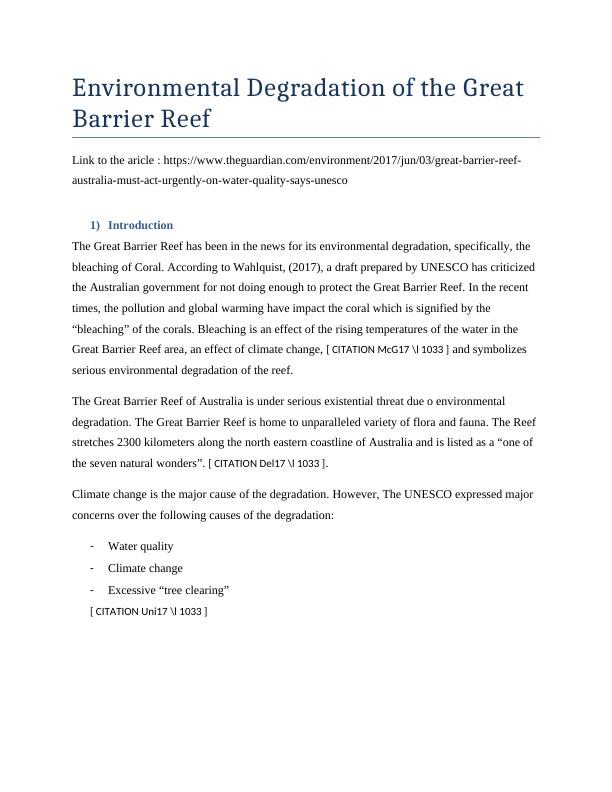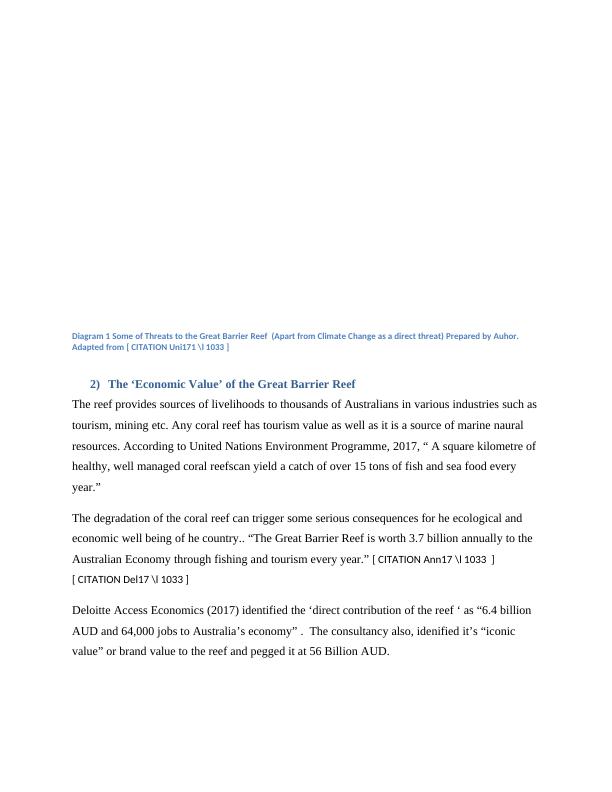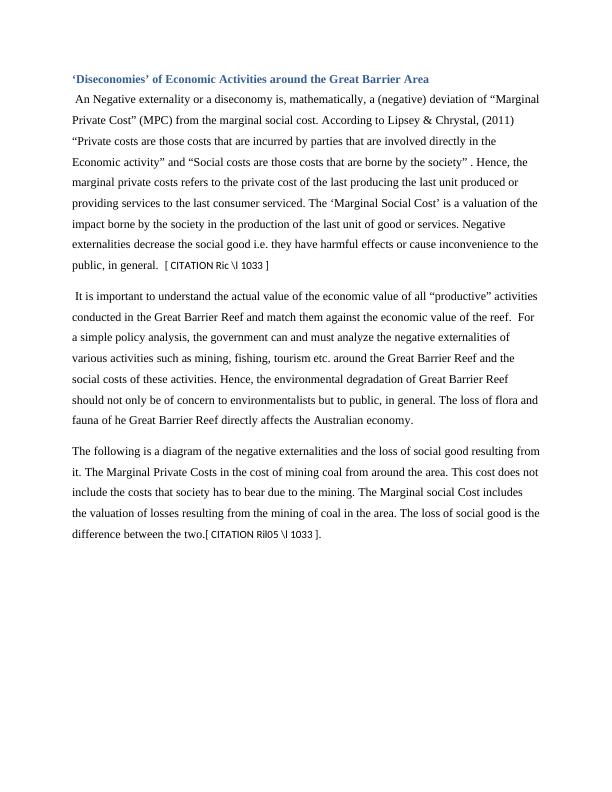The Great Barrier Reef of Australia must act urgently on water qualitysays-unesco
Added on 2020-03-01
7 Pages1748 Words147 Views
Environmental Degradation of the Great Barrier ReefLink to the aricle : https://www.theguardian.com/environment/2017/jun/03/great-barrier-reef-australia-must-act-urgently-on-water-quality-says-unesco1)IntroductionThe Great Barrier Reef has been in the news for its environmental degradation, specifically, the bleaching of Coral. According to Wahlquist, (2017), a draft prepared by UNESCO has criticized the Australian government for not doing enough to protect the Great Barrier Reef. In the recent times, the pollution and global warming have impact the coral which is signified by the “bleaching” of the corals. Bleaching is an effect of the rising temperatures of the water in the Great Barrier Reef area, an effect of climate change, [ CITATION McG17 \l 1033 ] and symbolizes serious environmental degradation of the reef. The Great Barrier Reef of Australia is under serious existential threat due o environmental degradation. The Great Barrier Reef is home to unparalleled variety of flora and fauna. The Reef stretches 2300 kilometers along the north eastern coastline of Australia and is listed as a “one of the seven natural wonders”. [ CITATION Del17 \l 1033 ].Climate change is the major cause of the degradation. However, The UNESCO expressed major concerns over the following causes of the degradation:-Water quality -Climate change-Excessive “tree clearing” [ CITATION Uni17 \l 1033 ]

Diagram 1 Some of Threats to the Great Barrier Reef (Apart from Climate Change as a direct threat) Prepared by Auhor. Adapted from [ CITATION Uni171 \l 1033 ]2)The ‘Economic Value’ of the Great Barrier ReefThe reef provides sources of livelihoods to thousands of Australians in various industries such astourism, mining etc. Any coral reef has tourism value as well as it is a source of marine naural resources. According to United Nations Environment Programme, 2017, “ A square kilometre of healthy, well managed coral reefscan yield a catch of over 15 tons of fish and sea food every year.”The degradation of the coral reef can trigger some serious consequences for he ecological and economic well being of he country.. “The Great Barrier Reef is worth 3.7 billion annually to the Australian Economy through fishing and tourism every year.” [ CITATION Ann17 \l 1033 ][ CITATION Del17 \l 1033 ]Deloitte Access Economics (2017) identified the ‘direct contribution of the reef ‘ as “6.4 billion AUD and 64,000 jobs to Australia’s economy” . The consultancy also, idenified it’s “iconic value” or brand value to the reef and pegged it at 56 Billion AUD. Oil SpillsExcessive Fishing

‘Diseconomies’ of Economic Activities around the Great Barrier Area An Negative externality or a diseconomy is, mathematically, a (negative) deviation of “MarginalPrivate Cost” (MPC) from the marginal social cost. According to Lipsey & Chrystal, (2011) “Private costs are those costs that are incurred by parties that are involved directly in the Economic activity” and “Social costs are those costs that are borne by the society” . Hence, the marginal private costs refers to the private cost of the last producing the last unit produced or providing services to the last consumer serviced. The ‘Marginal Social Cost’ is a valuation of theimpact borne by the society in the production of the last unit of good or services. Negative externalities decrease the social good i.e. they have harmful effects or cause inconvenience to thepublic, in general. [ CITATION Ric \l 1033 ] It is important to understand the actual value of the economic value of all “productive” activitiesconducted in the Great Barrier Reef and match them against the economic value of the reef. For a simple policy analysis, the government can and must analyze the negative externalities of various activities such as mining, fishing, tourism etc. around the Great Barrier Reef and the social costs of these activities. Hence, the environmental degradation of Great Barrier Reef should not only be of concern to environmentalists but to public, in general. The loss of flora andfauna of he Great Barrier Reef directly affects the Australian economy.The following is a diagram of the negative externalities and the loss of social good resulting fromit. The Marginal Private Costs in the cost of mining coal from around the area. This cost does notinclude the costs that society has to bear due to the mining. The Marginal social Cost includes the valuation of losses resulting from the mining of coal in the area. The loss of social good is thedifference between the two.[ CITATION Ril05 \l 1033 ].

End of preview
Want to access all the pages? Upload your documents or become a member.
Related Documents
Application For Sustainable Tourism Fundinglg...
|7
|1935
|147
The Economic Impact of the Environmental Effect on Great Barrier Reeflg...
|5
|1269
|95
The Great Barrier Reef: Threats, Values, and Conservationlg...
|12
|2807
|469
Tourism Business in the Great Barrier Reeflg...
|5
|1005
|376
HI5003 - Newspaper Analysislg...
|6
|1440
|59
Hospitality and Tourism Marketlg...
|5
|1064
|282
